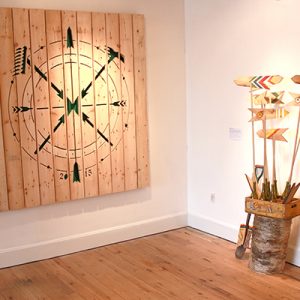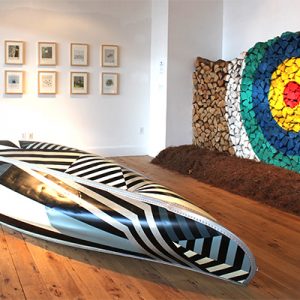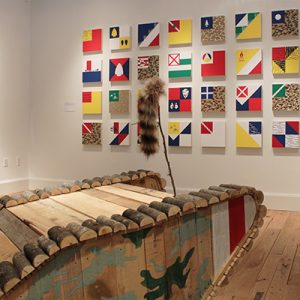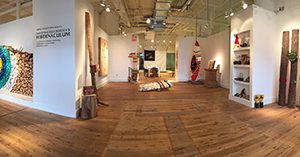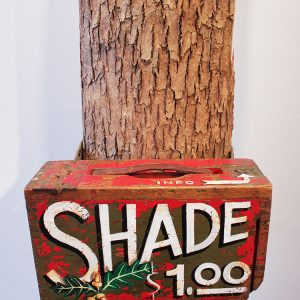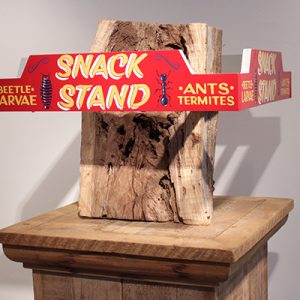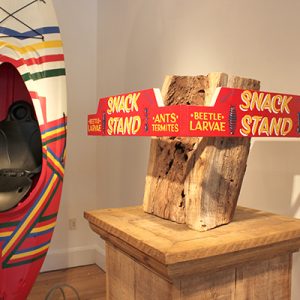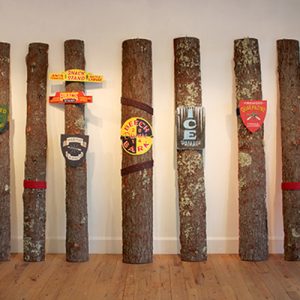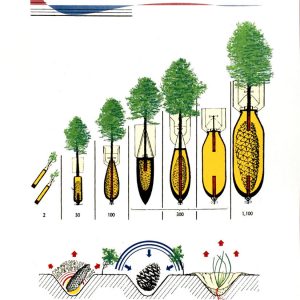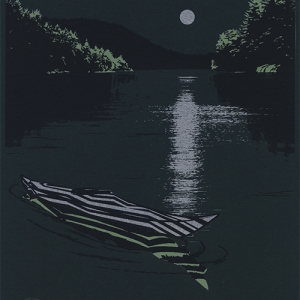It is not every day that we come across artwork that sincerely encourages us to reflect on and rethink our human relationship with Mother Nature. Sure, many artists draw inspiration from our environment’s beauty and the activities we do in the outdoors, but how many creatives really make us question and explore the several positive AND negative aspects of our society’s interactions with nature? We recently learned about an artist who does just that and his work is absolutely fascinating.
David Buckley Borden, a multidisciplinary artist and formally trained landscape architect, partnered with print collective Trifecta Editions to create the Hibernaculum exhibition in the Innovation and Design Building in Boston. The installation will be on display through the rest of July, celebrating collaborative art and design inspired by nature and continuing Borden’s ongoing exploration of communicating environmental issues through creative projects.
The exhibition has four parts, all drawing upon Borden’s yearlong experience as the Hibernaculum Artist in Residency at an Eagle Lake retreat in the Adirondacks. The first part is a “Fashion Cabin” with welcoming highlights to foreground the influence of the great outdoors on interior design. The second room features large-scale works, adapted from site-specific installations created on the Eagle Lake landscape. The third space spotlights Borden’s collaborative silkscreen print series and mixed media work focused on ecology, natural history and environmental-based design. Lastly, there is a design research library with a furnished reading room and various publications available for visitors to research Borden’s projects through the lens of various topics like Native American architecture and the Adirondack great camps.
We really love how David Buckley Borden creates artwork that makes environmental issues relevant and relatable, so we asked him a few questions about his experiences in the Hibernaculum Residency and how he developed the exhibition pieces to be both educational and a beautiful presentation of the Adirondack landscape.
Q. What aspects of nature influence your artistic style most?
Ecology is a conceptual theme that spans most of my work. I identify as a multidisciplinary artist/designer and employ a variety of media to communicate ecological issues and phenomena. The place in which my project work is focused has a direct impact on how I represent subject matter. For example, the Hibernaculum project channels the visual language of summer in the Adirondacks: camping, tents, Hudson’s Bay blankets, roadside snack stands, canoe trips, wood crafts and the like. I employed this “style” to foreground various ecological issues in the Adirondack landscape. However, my style changes in response to the place. My upcoming project focuses on the Greater Yellowstone Ecosystem and employs an entirely different visual language that is rooted in the cultural landscape of Wyoming, Yellowstone National Park and the conflicts between conservation and ecological tourism found within that ecosystem.
Q. What were you most inspired by while in the Hibernaculum Residency at Eagle Lake?
A. I often state that my work is place-based, but it may be more accurate to say it’s based on the experience of place. I loved just being at Eagle Lake, free from emails, iPhones and other distractions. It’s as if you’re in a big vacuum that creates a void you can fill with new ideas based on the nuances of the place. Spending a good deal of time in one place promotes deep appreciation, and the more I began to appreciate Eagle Lake, the more creative I was in communicating the environmental issues that threaten it.
Q. Which environmental issues concern you most and why?
A. I think the most concerning environmental issue is not an issue of ecology, but instead, an issue of culture. Without strong cultural cohesion around ecological issues, the environment will continue to be degraded. In service of education and ultimately the adoption of sound ecological practice, we must make environmental issues culturally relevant and accessible to the general population. That’s what I’m trying to do by way of art and design.
Q. How does the Hibernaculum exhibition convey your concerns for the environment and your interest in building a cultural value of ecology?
A. It is said that landscape ecology plays out on a regional scale, but occurs locally. The same could be said of the adoption of environmentally sensitive lifestyles. Success may be measured in terms of mainstream adoption, but it occurs one individual at a time. In practice, both our collective and individual values shape our built environment. Ecological awareness is a powerful mechanism for environmental change. To that end, I believe that both art and design are powerful tools to foster cultural cohesion around ecological issues. Based on my own experience and experiments, the lesson is clear: to make an impression, artwork must be accessible, informative and engaging. Making eco-based work that is remarkable and relevant to popular culture in one way or another is critical. There are many ways to do so, but my most successful efforts, including the Hibernaculum, typically employ a combination of humor and beauty with undercurrents of pop culture sensibility.
Q. So, in many ways, your work is highly educational.
A. Absolutely. Sometimes I describe my work as art, sometimes as design, and sometimes I describe it as a giant ambitious communication project. I also described it as educational. I agree with Paulo Freire, the late Brazilian educator and philosopher, that education is the most transformative, value-producing system in society. An informed public with a shared ecological awareness will be in a better position to support ecology-sensitive lifestyles. Ultimately, an informed public is in a position to become their own empowered advocates and are more likely to assume an active role in protecting their environment.
Q. Which part of the exhibition was the most enjoyable to create?
A. I try not to play favorites. I appreciate all of the work for different reasons and in many ways, as each piece supplements the others. I enjoy screen printing because working with Helen and Morgan from Trifecta Editions is both fun and fulfilling. Helen and Morgan push me to explore new directions and are constantly teaching me new things about printmaking. I also love the print medium because it’s an accessible means by which I can share ideas. People can literally take the work in the exhibition home. I find that I appreciate the large-scale installations in the show because I tend to think as a spatial designer. The fact that a visitor can walk around, through or even in a piece of work, lends a lot to the experience of the art. It’s these meaningful experiences that I am ultimately aiming to create.
Q. Do you have a favorite piece from the exhibition?
A. I think the Hibernaculum installation, as a whole experience, would be my favorite piece. I often describe the exhibition as an immersive installation in that it’s designed to be an experience in and of itself. The Hibernaculum is not just defined by the artwork. It also includes the relationship between the various installations and print series, the smell of green wood and pine duff, the layout of the five gallery spaces, the lighting, the soundtrack, and ultimately, the reaction from visitors and the ensuing conversations.
Artwork by David Buckley Borden.
XX SYDNEY

